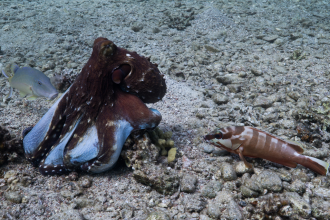Media release
From:
Ecology: Shared leadership in octopus-fish hunting groups *IMAGES & VIDEO*
Some octopus and fish species appear to share leadership when hunting prey together, according to a Nature Ecology & Evolution paper. The findings broaden our understanding of the sophisticated cross-species social life of octopuses and fish.
Octopuses, which are often considered to be solitary animals, have been observed to hunt in groups with different species of fish — including several species of goatfish and groupers — for shared prey such as molluscs and crustaceans. Previous observations of these groups suggested that the octopus lead the hunt while the fish usually follow. More complex group interactions between octopuses and fish have been suggested, but these are challenging to document.
Eduardo Sampaio and colleagues tracked octopus–fish hunting packs during scuba diving expeditions in the Red Sea. They observed hunting groups consisting of one day octopus and different species of fish, including gold-saddle goatfish and blacktip groupers, totalling 13 groups. After collecting and analysing data from 120 hours of underwater dives, the authors report that leadership is shared among groups for different types of decisions. For example, goatfish specialized in environmental exploration — deciding where the hunting pack moves — while the octopus decided whether and when the move would be made. This joint effort leads to higher hunting success compared to the octopus or fish acting alone, depending on group composition. Sampaio and colleagues also observed aggressive control mechanisms amongst groups members, including fish displacing others by darting towards them and octopuses displacing fish to outer areas of the group by punching them.
The authors note that whilst other types of mixed-species hunting pack are known — such as badger–coyote, mixed birds, and moray eel–grouper groups — they appear to be less behaviourally flexible in using social information to change strategy compared to octopus–fish hunting groups.
Multimedia







 International
International


